Employability Skills Report: NHS Staff Development and Performance
VerifiedAdded on 2021/01/01
|15
|3724
|360
Report
AI Summary
This report focuses on employability skills within the National Health Service (NHS), examining various aspects crucial for professional development. The report begins with an introduction to employability skills and their importance in the healthcare sector. Part 1 delves into developing personal responsibilities and performance objectives, using self-appraisal and SWOT analysis to evaluate effectiveness. Recommendations for improvement are provided, along with a review of motivational techniques. Part 2 addresses work-based problem-solving, exploring different communication styles and their impact, and effective time management strategies. Part 3 analyzes the roles people play in teams, team dynamics, and alternative methods for achieving goals. Finally, Part 4 evaluates tools and methods for problem-solving and developing strategies with consideration for business impact. The report concludes with a summary of findings and includes references.
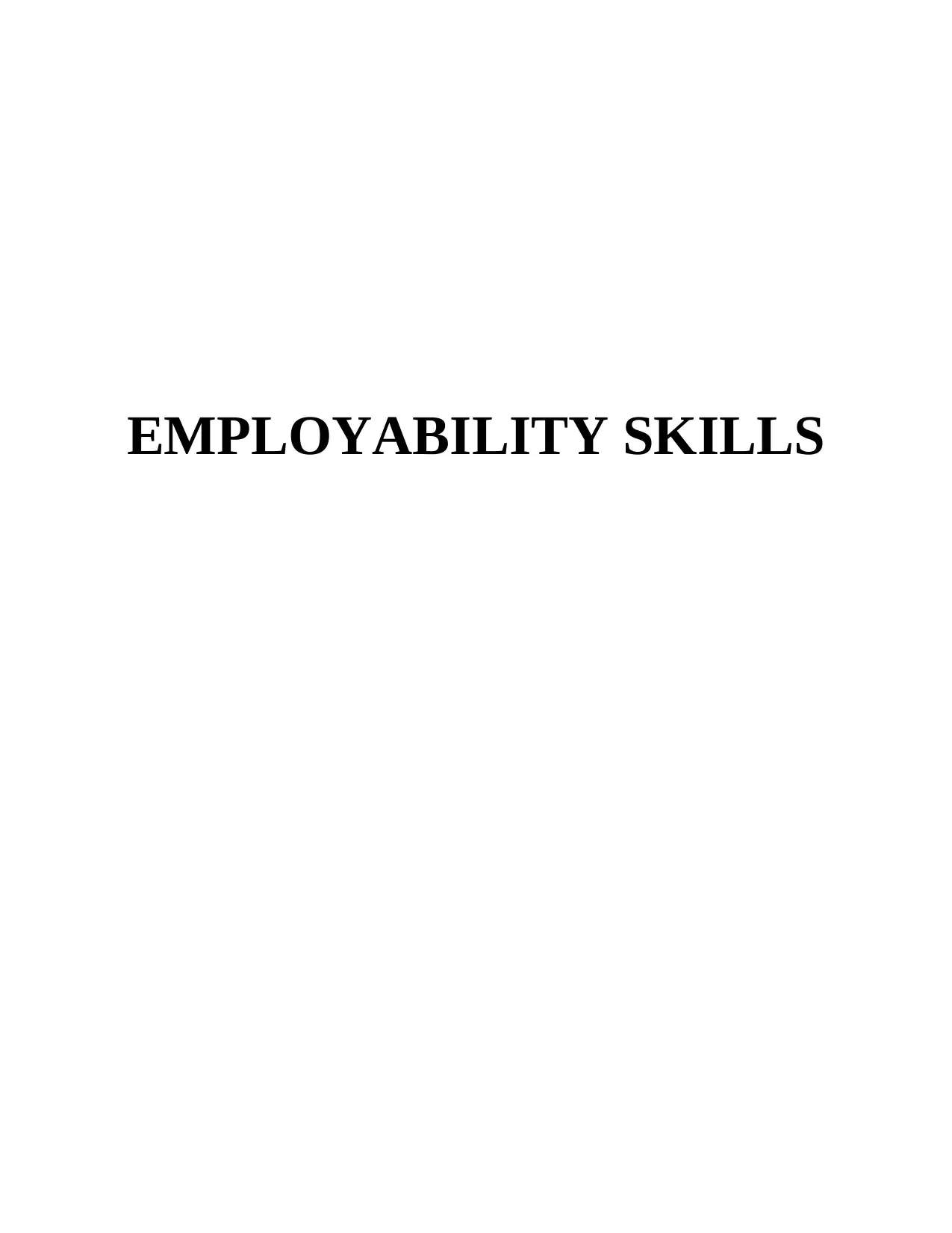
EMPLOYABILITY SKILLS
Paraphrase This Document
Need a fresh take? Get an instant paraphrase of this document with our AI Paraphraser
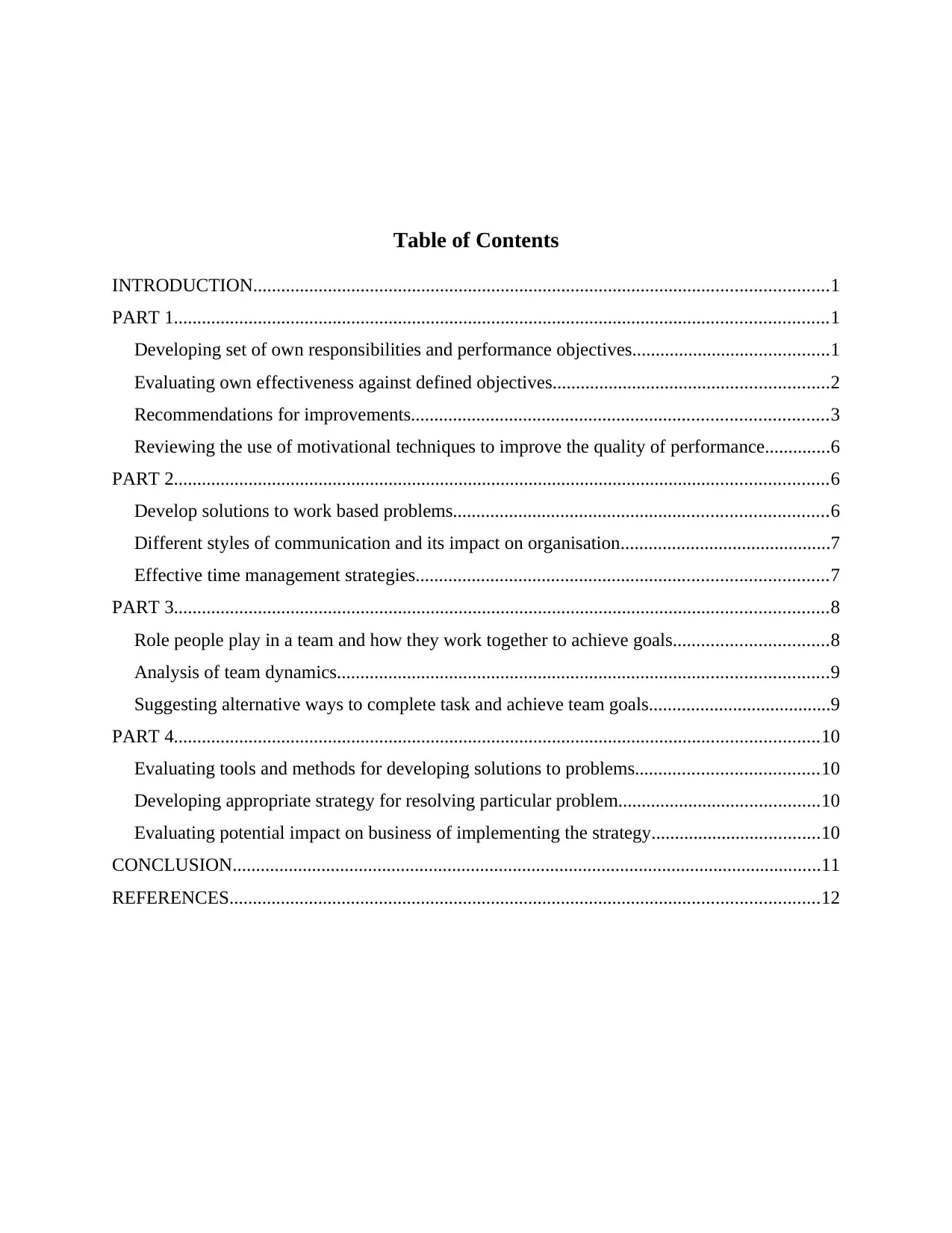
Table of Contents
INTRODUCTION...........................................................................................................................1
PART 1............................................................................................................................................1
Developing set of own responsibilities and performance objectives..........................................1
Evaluating own effectiveness against defined objectives...........................................................2
Recommendations for improvements.........................................................................................3
Reviewing the use of motivational techniques to improve the quality of performance..............6
PART 2............................................................................................................................................6
Develop solutions to work based problems................................................................................6
Different styles of communication and its impact on organisation.............................................7
Effective time management strategies........................................................................................7
PART 3............................................................................................................................................8
Role people play in a team and how they work together to achieve goals.................................8
Analysis of team dynamics.........................................................................................................9
Suggesting alternative ways to complete task and achieve team goals.......................................9
PART 4..........................................................................................................................................10
Evaluating tools and methods for developing solutions to problems.......................................10
Developing appropriate strategy for resolving particular problem...........................................10
Evaluating potential impact on business of implementing the strategy....................................10
CONCLUSION..............................................................................................................................11
REFERENCES..............................................................................................................................12
INTRODUCTION...........................................................................................................................1
PART 1............................................................................................................................................1
Developing set of own responsibilities and performance objectives..........................................1
Evaluating own effectiveness against defined objectives...........................................................2
Recommendations for improvements.........................................................................................3
Reviewing the use of motivational techniques to improve the quality of performance..............6
PART 2............................................................................................................................................6
Develop solutions to work based problems................................................................................6
Different styles of communication and its impact on organisation.............................................7
Effective time management strategies........................................................................................7
PART 3............................................................................................................................................8
Role people play in a team and how they work together to achieve goals.................................8
Analysis of team dynamics.........................................................................................................9
Suggesting alternative ways to complete task and achieve team goals.......................................9
PART 4..........................................................................................................................................10
Evaluating tools and methods for developing solutions to problems.......................................10
Developing appropriate strategy for resolving particular problem...........................................10
Evaluating potential impact on business of implementing the strategy....................................10
CONCLUSION..............................................................................................................................11
REFERENCES..............................................................................................................................12

⊘ This is a preview!⊘
Do you want full access?
Subscribe today to unlock all pages.

Trusted by 1+ million students worldwide
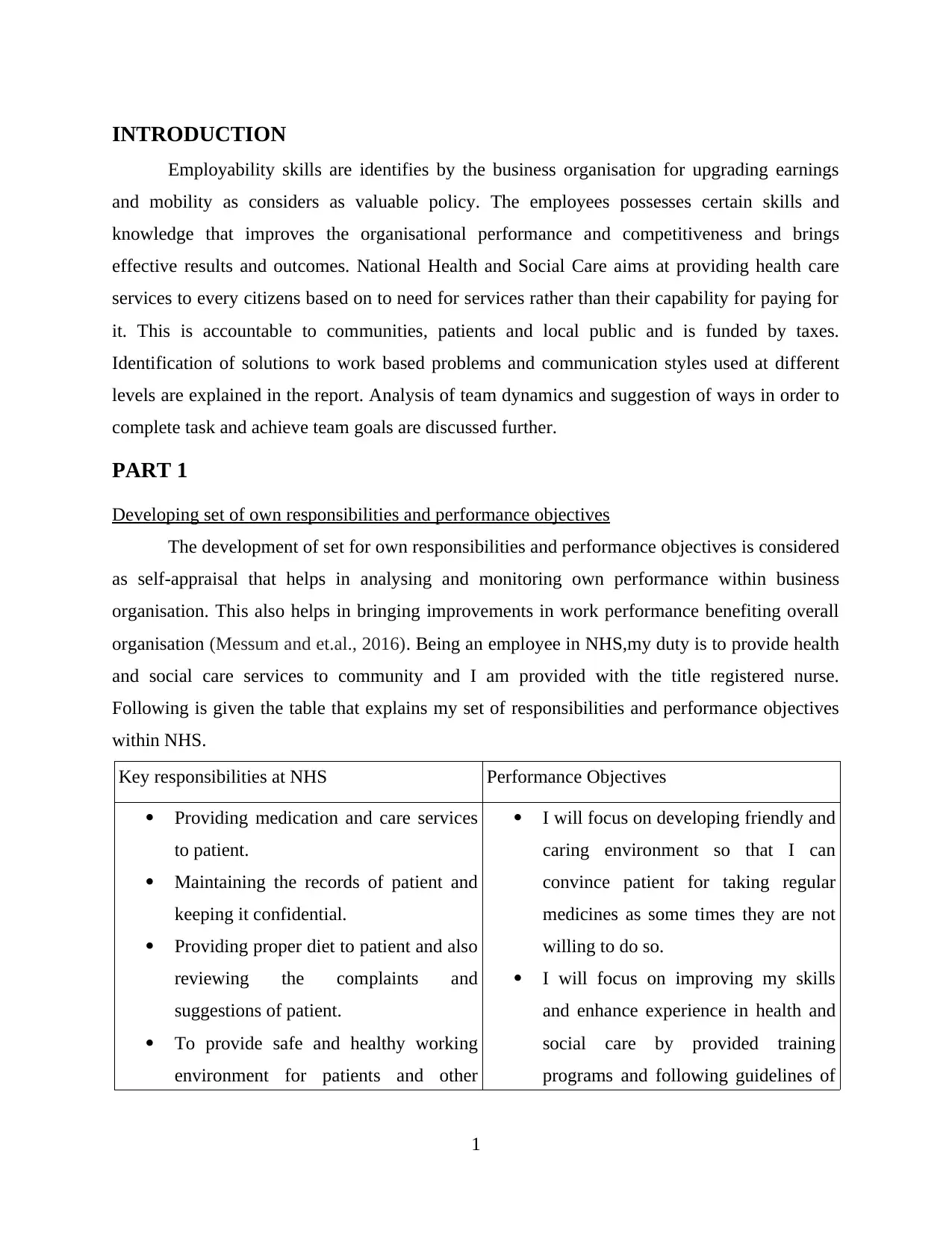
INTRODUCTION
Employability skills are identifies by the business organisation for upgrading earnings
and mobility as considers as valuable policy. The employees possesses certain skills and
knowledge that improves the organisational performance and competitiveness and brings
effective results and outcomes. National Health and Social Care aims at providing health care
services to every citizens based on to need for services rather than their capability for paying for
it. This is accountable to communities, patients and local public and is funded by taxes.
Identification of solutions to work based problems and communication styles used at different
levels are explained in the report. Analysis of team dynamics and suggestion of ways in order to
complete task and achieve team goals are discussed further.
PART 1
Developing set of own responsibilities and performance objectives
The development of set for own responsibilities and performance objectives is considered
as self-appraisal that helps in analysing and monitoring own performance within business
organisation. This also helps in bringing improvements in work performance benefiting overall
organisation (Messum and et.al., 2016). Being an employee in NHS,my duty is to provide health
and social care services to community and I am provided with the title registered nurse.
Following is given the table that explains my set of responsibilities and performance objectives
within NHS.
Key responsibilities at NHS Performance Objectives
Providing medication and care services
to patient.
Maintaining the records of patient and
keeping it confidential.
Providing proper diet to patient and also
reviewing the complaints and
suggestions of patient.
To provide safe and healthy working
environment for patients and other
I will focus on developing friendly and
caring environment so that I can
convince patient for taking regular
medicines as some times they are not
willing to do so.
I will focus on improving my skills
and enhance experience in health and
social care by provided training
programs and following guidelines of
1
Employability skills are identifies by the business organisation for upgrading earnings
and mobility as considers as valuable policy. The employees possesses certain skills and
knowledge that improves the organisational performance and competitiveness and brings
effective results and outcomes. National Health and Social Care aims at providing health care
services to every citizens based on to need for services rather than their capability for paying for
it. This is accountable to communities, patients and local public and is funded by taxes.
Identification of solutions to work based problems and communication styles used at different
levels are explained in the report. Analysis of team dynamics and suggestion of ways in order to
complete task and achieve team goals are discussed further.
PART 1
Developing set of own responsibilities and performance objectives
The development of set for own responsibilities and performance objectives is considered
as self-appraisal that helps in analysing and monitoring own performance within business
organisation. This also helps in bringing improvements in work performance benefiting overall
organisation (Messum and et.al., 2016). Being an employee in NHS,my duty is to provide health
and social care services to community and I am provided with the title registered nurse.
Following is given the table that explains my set of responsibilities and performance objectives
within NHS.
Key responsibilities at NHS Performance Objectives
Providing medication and care services
to patient.
Maintaining the records of patient and
keeping it confidential.
Providing proper diet to patient and also
reviewing the complaints and
suggestions of patient.
To provide safe and healthy working
environment for patients and other
I will focus on developing friendly and
caring environment so that I can
convince patient for taking regular
medicines as some times they are not
willing to do so.
I will focus on improving my skills
and enhance experience in health and
social care by provided training
programs and following guidelines of
1
Paraphrase This Document
Need a fresh take? Get an instant paraphrase of this document with our AI Paraphraser
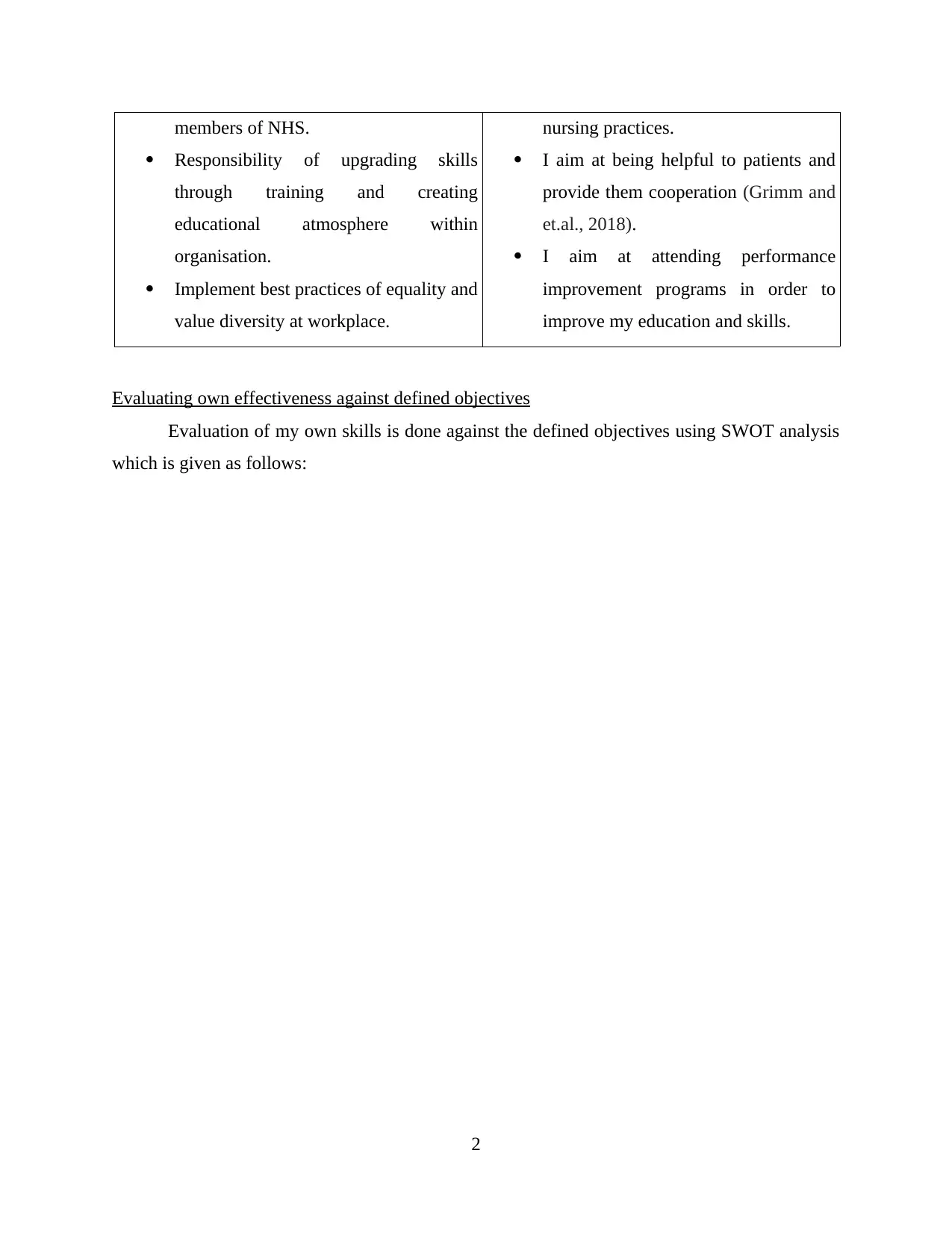
members of NHS.
Responsibility of upgrading skills
through training and creating
educational atmosphere within
organisation.
Implement best practices of equality and
value diversity at workplace.
nursing practices.
I aim at being helpful to patients and
provide them cooperation (Grimm and
et.al., 2018).
I aim at attending performance
improvement programs in order to
improve my education and skills.
Evaluating own effectiveness against defined objectives
Evaluation of my own skills is done against the defined objectives using SWOT analysis
which is given as follows:
2
Responsibility of upgrading skills
through training and creating
educational atmosphere within
organisation.
Implement best practices of equality and
value diversity at workplace.
nursing practices.
I aim at being helpful to patients and
provide them cooperation (Grimm and
et.al., 2018).
I aim at attending performance
improvement programs in order to
improve my education and skills.
Evaluating own effectiveness against defined objectives
Evaluation of my own skills is done against the defined objectives using SWOT analysis
which is given as follows:
2
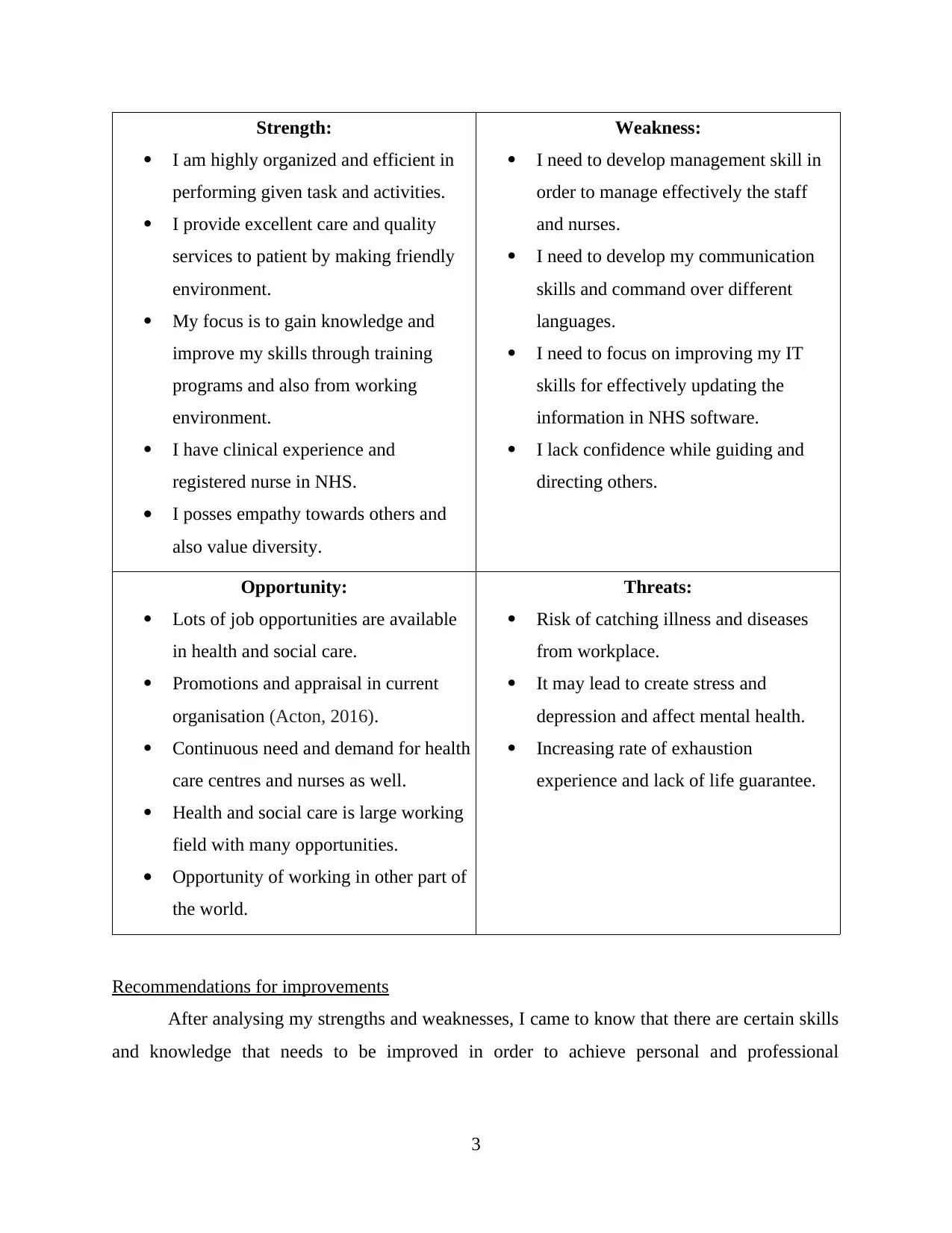
Strength:
I am highly organized and efficient in
performing given task and activities.
I provide excellent care and quality
services to patient by making friendly
environment.
My focus is to gain knowledge and
improve my skills through training
programs and also from working
environment.
I have clinical experience and
registered nurse in NHS.
I posses empathy towards others and
also value diversity.
Weakness:
I need to develop management skill in
order to manage effectively the staff
and nurses.
I need to develop my communication
skills and command over different
languages.
I need to focus on improving my IT
skills for effectively updating the
information in NHS software.
I lack confidence while guiding and
directing others.
Opportunity:
Lots of job opportunities are available
in health and social care.
Promotions and appraisal in current
organisation (Acton, 2016).
Continuous need and demand for health
care centres and nurses as well.
Health and social care is large working
field with many opportunities.
Opportunity of working in other part of
the world.
Threats:
Risk of catching illness and diseases
from workplace.
It may lead to create stress and
depression and affect mental health.
Increasing rate of exhaustion
experience and lack of life guarantee.
Recommendations for improvements
After analysing my strengths and weaknesses, I came to know that there are certain skills
and knowledge that needs to be improved in order to achieve personal and professional
3
I am highly organized and efficient in
performing given task and activities.
I provide excellent care and quality
services to patient by making friendly
environment.
My focus is to gain knowledge and
improve my skills through training
programs and also from working
environment.
I have clinical experience and
registered nurse in NHS.
I posses empathy towards others and
also value diversity.
Weakness:
I need to develop management skill in
order to manage effectively the staff
and nurses.
I need to develop my communication
skills and command over different
languages.
I need to focus on improving my IT
skills for effectively updating the
information in NHS software.
I lack confidence while guiding and
directing others.
Opportunity:
Lots of job opportunities are available
in health and social care.
Promotions and appraisal in current
organisation (Acton, 2016).
Continuous need and demand for health
care centres and nurses as well.
Health and social care is large working
field with many opportunities.
Opportunity of working in other part of
the world.
Threats:
Risk of catching illness and diseases
from workplace.
It may lead to create stress and
depression and affect mental health.
Increasing rate of exhaustion
experience and lack of life guarantee.
Recommendations for improvements
After analysing my strengths and weaknesses, I came to know that there are certain skills
and knowledge that needs to be improved in order to achieve personal and professional
3
⊘ This is a preview!⊘
Do you want full access?
Subscribe today to unlock all pages.

Trusted by 1+ million students worldwide
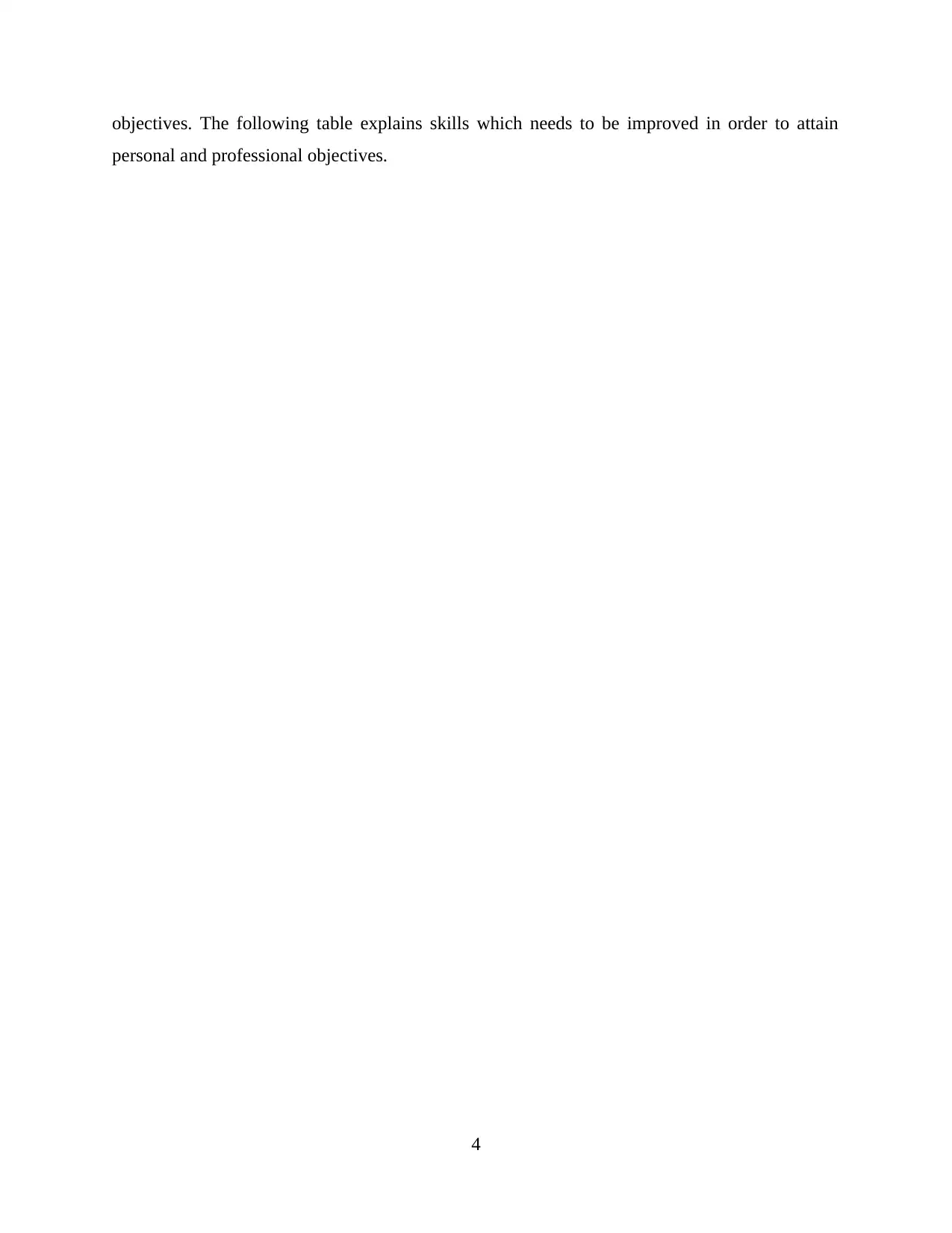
objectives. The following table explains skills which needs to be improved in order to attain
personal and professional objectives.
4
personal and professional objectives.
4
Paraphrase This Document
Need a fresh take? Get an instant paraphrase of this document with our AI Paraphraser
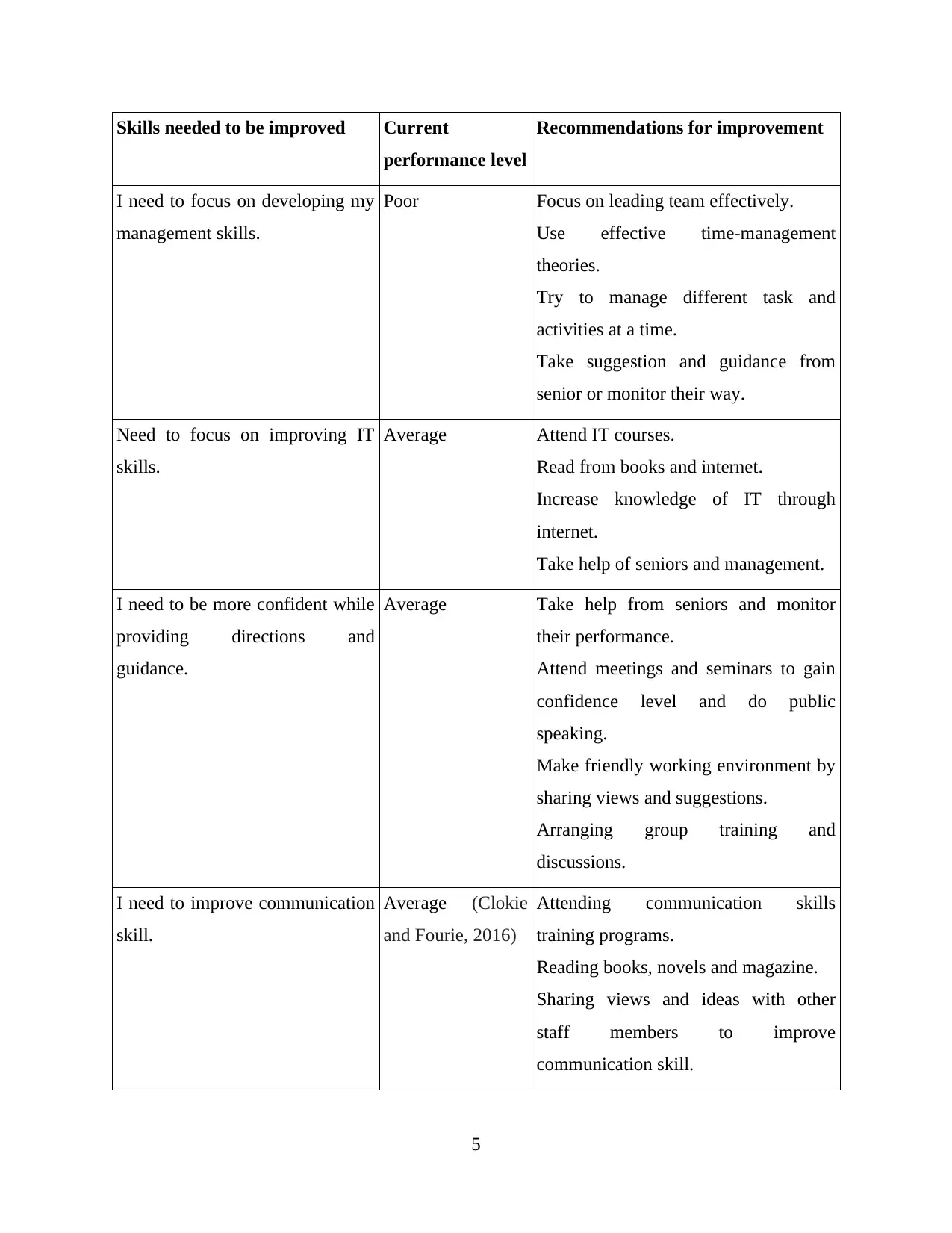
Skills needed to be improved Current
performance level
Recommendations for improvement
I need to focus on developing my
management skills.
Poor Focus on leading team effectively.
Use effective time-management
theories.
Try to manage different task and
activities at a time.
Take suggestion and guidance from
senior or monitor their way.
Need to focus on improving IT
skills.
Average Attend IT courses.
Read from books and internet.
Increase knowledge of IT through
internet.
Take help of seniors and management.
I need to be more confident while
providing directions and
guidance.
Average Take help from seniors and monitor
their performance.
Attend meetings and seminars to gain
confidence level and do public
speaking.
Make friendly working environment by
sharing views and suggestions.
Arranging group training and
discussions.
I need to improve communication
skill.
Average (Clokie
and Fourie, 2016)
Attending communication skills
training programs.
Reading books, novels and magazine.
Sharing views and ideas with other
staff members to improve
communication skill.
5
performance level
Recommendations for improvement
I need to focus on developing my
management skills.
Poor Focus on leading team effectively.
Use effective time-management
theories.
Try to manage different task and
activities at a time.
Take suggestion and guidance from
senior or monitor their way.
Need to focus on improving IT
skills.
Average Attend IT courses.
Read from books and internet.
Increase knowledge of IT through
internet.
Take help of seniors and management.
I need to be more confident while
providing directions and
guidance.
Average Take help from seniors and monitor
their performance.
Attend meetings and seminars to gain
confidence level and do public
speaking.
Make friendly working environment by
sharing views and suggestions.
Arranging group training and
discussions.
I need to improve communication
skill.
Average (Clokie
and Fourie, 2016)
Attending communication skills
training programs.
Reading books, novels and magazine.
Sharing views and ideas with other
staff members to improve
communication skill.
5
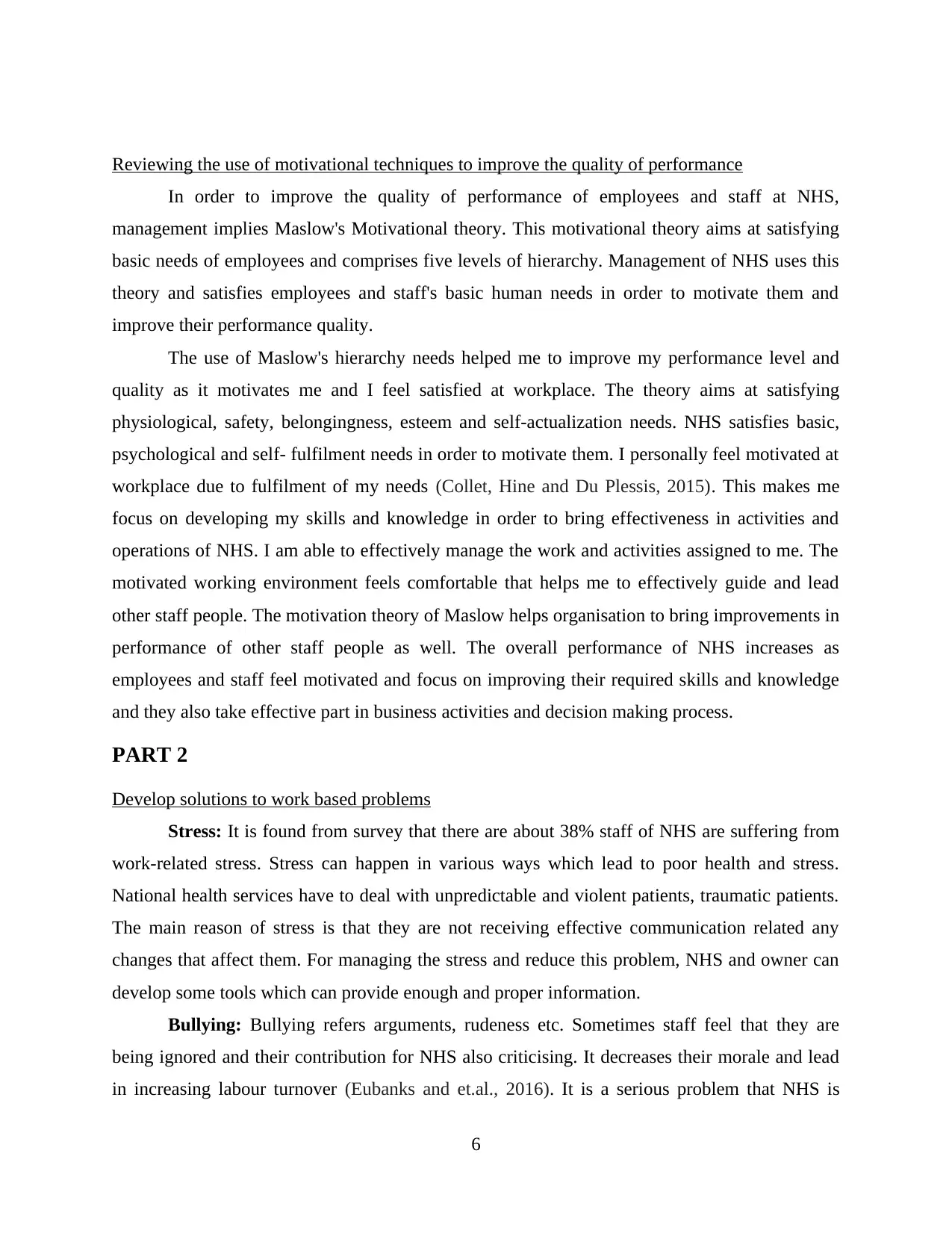
Reviewing the use of motivational techniques to improve the quality of performance
In order to improve the quality of performance of employees and staff at NHS,
management implies Maslow's Motivational theory. This motivational theory aims at satisfying
basic needs of employees and comprises five levels of hierarchy. Management of NHS uses this
theory and satisfies employees and staff's basic human needs in order to motivate them and
improve their performance quality.
The use of Maslow's hierarchy needs helped me to improve my performance level and
quality as it motivates me and I feel satisfied at workplace. The theory aims at satisfying
physiological, safety, belongingness, esteem and self-actualization needs. NHS satisfies basic,
psychological and self- fulfilment needs in order to motivate them. I personally feel motivated at
workplace due to fulfilment of my needs (Collet, Hine and Du Plessis, 2015). This makes me
focus on developing my skills and knowledge in order to bring effectiveness in activities and
operations of NHS. I am able to effectively manage the work and activities assigned to me. The
motivated working environment feels comfortable that helps me to effectively guide and lead
other staff people. The motivation theory of Maslow helps organisation to bring improvements in
performance of other staff people as well. The overall performance of NHS increases as
employees and staff feel motivated and focus on improving their required skills and knowledge
and they also take effective part in business activities and decision making process.
PART 2
Develop solutions to work based problems
Stress: It is found from survey that there are about 38% staff of NHS are suffering from
work-related stress. Stress can happen in various ways which lead to poor health and stress.
National health services have to deal with unpredictable and violent patients, traumatic patients.
The main reason of stress is that they are not receiving effective communication related any
changes that affect them. For managing the stress and reduce this problem, NHS and owner can
develop some tools which can provide enough and proper information.
Bullying: Bullying refers arguments, rudeness etc. Sometimes staff feel that they are
being ignored and their contribution for NHS also criticising. It decreases their morale and lead
in increasing labour turnover (Eubanks and et.al., 2016). It is a serious problem that NHS is
6
In order to improve the quality of performance of employees and staff at NHS,
management implies Maslow's Motivational theory. This motivational theory aims at satisfying
basic needs of employees and comprises five levels of hierarchy. Management of NHS uses this
theory and satisfies employees and staff's basic human needs in order to motivate them and
improve their performance quality.
The use of Maslow's hierarchy needs helped me to improve my performance level and
quality as it motivates me and I feel satisfied at workplace. The theory aims at satisfying
physiological, safety, belongingness, esteem and self-actualization needs. NHS satisfies basic,
psychological and self- fulfilment needs in order to motivate them. I personally feel motivated at
workplace due to fulfilment of my needs (Collet, Hine and Du Plessis, 2015). This makes me
focus on developing my skills and knowledge in order to bring effectiveness in activities and
operations of NHS. I am able to effectively manage the work and activities assigned to me. The
motivated working environment feels comfortable that helps me to effectively guide and lead
other staff people. The motivation theory of Maslow helps organisation to bring improvements in
performance of other staff people as well. The overall performance of NHS increases as
employees and staff feel motivated and focus on improving their required skills and knowledge
and they also take effective part in business activities and decision making process.
PART 2
Develop solutions to work based problems
Stress: It is found from survey that there are about 38% staff of NHS are suffering from
work-related stress. Stress can happen in various ways which lead to poor health and stress.
National health services have to deal with unpredictable and violent patients, traumatic patients.
The main reason of stress is that they are not receiving effective communication related any
changes that affect them. For managing the stress and reduce this problem, NHS and owner can
develop some tools which can provide enough and proper information.
Bullying: Bullying refers arguments, rudeness etc. Sometimes staff feel that they are
being ignored and their contribution for NHS also criticising. It decreases their morale and lead
in increasing labour turnover (Eubanks and et.al., 2016). It is a serious problem that NHS is
6
⊘ This is a preview!⊘
Do you want full access?
Subscribe today to unlock all pages.

Trusted by 1+ million students worldwide
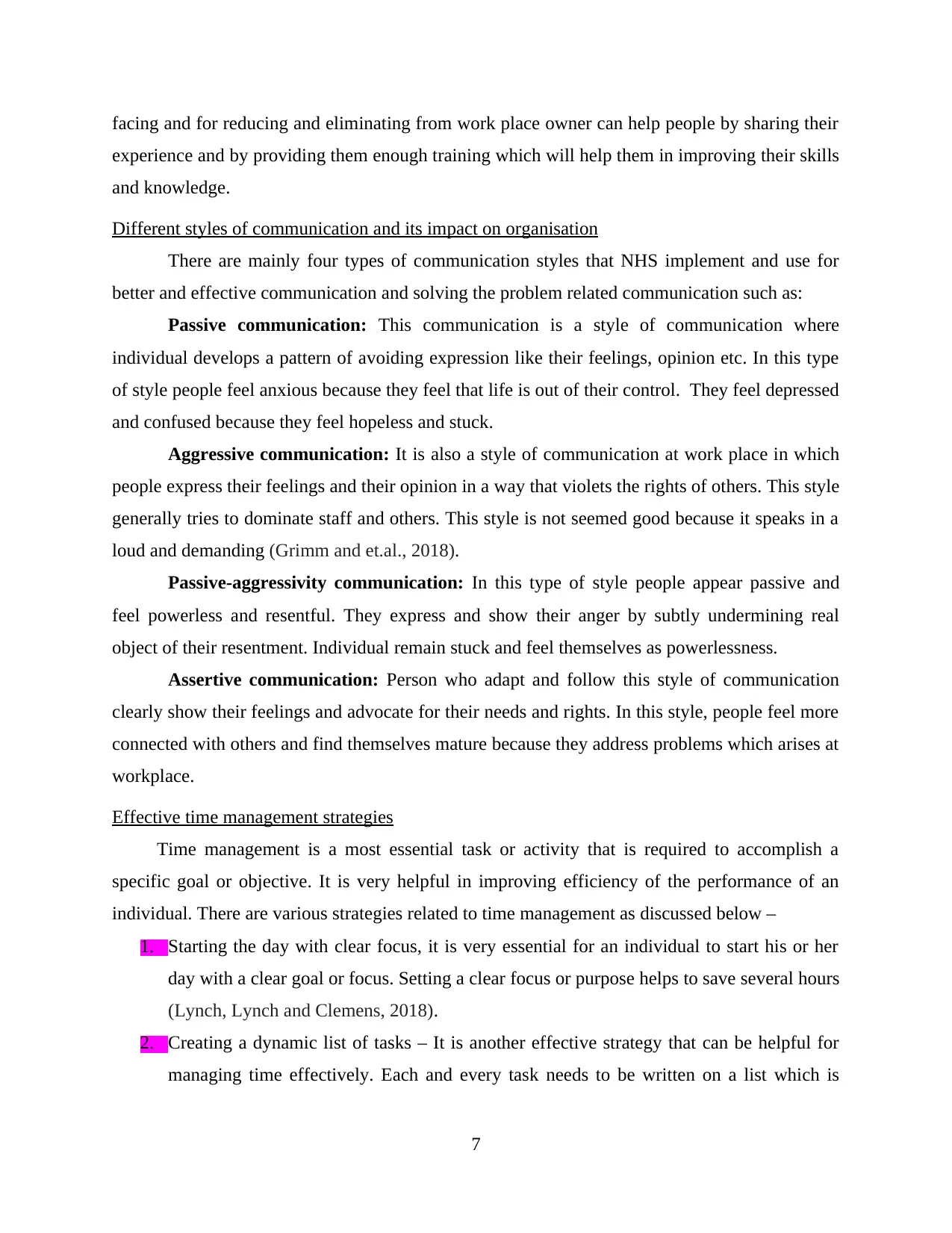
facing and for reducing and eliminating from work place owner can help people by sharing their
experience and by providing them enough training which will help them in improving their skills
and knowledge.
Different styles of communication and its impact on organisation
There are mainly four types of communication styles that NHS implement and use for
better and effective communication and solving the problem related communication such as:
Passive communication: This communication is a style of communication where
individual develops a pattern of avoiding expression like their feelings, opinion etc. In this type
of style people feel anxious because they feel that life is out of their control. They feel depressed
and confused because they feel hopeless and stuck.
Aggressive communication: It is also a style of communication at work place in which
people express their feelings and their opinion in a way that violets the rights of others. This style
generally tries to dominate staff and others. This style is not seemed good because it speaks in a
loud and demanding (Grimm and et.al., 2018).
Passive-aggressivity communication: In this type of style people appear passive and
feel powerless and resentful. They express and show their anger by subtly undermining real
object of their resentment. Individual remain stuck and feel themselves as powerlessness.
Assertive communication: Person who adapt and follow this style of communication
clearly show their feelings and advocate for their needs and rights. In this style, people feel more
connected with others and find themselves mature because they address problems which arises at
workplace.
Effective time management strategies
Time management is a most essential task or activity that is required to accomplish a
specific goal or objective. It is very helpful in improving efficiency of the performance of an
individual. There are various strategies related to time management as discussed below –
1. Starting the day with clear focus, it is very essential for an individual to start his or her
day with a clear goal or focus. Setting a clear focus or purpose helps to save several hours
(Lynch, Lynch and Clemens, 2018).
2. Creating a dynamic list of tasks – It is another effective strategy that can be helpful for
managing time effectively. Each and every task needs to be written on a list which is
7
experience and by providing them enough training which will help them in improving their skills
and knowledge.
Different styles of communication and its impact on organisation
There are mainly four types of communication styles that NHS implement and use for
better and effective communication and solving the problem related communication such as:
Passive communication: This communication is a style of communication where
individual develops a pattern of avoiding expression like their feelings, opinion etc. In this type
of style people feel anxious because they feel that life is out of their control. They feel depressed
and confused because they feel hopeless and stuck.
Aggressive communication: It is also a style of communication at work place in which
people express their feelings and their opinion in a way that violets the rights of others. This style
generally tries to dominate staff and others. This style is not seemed good because it speaks in a
loud and demanding (Grimm and et.al., 2018).
Passive-aggressivity communication: In this type of style people appear passive and
feel powerless and resentful. They express and show their anger by subtly undermining real
object of their resentment. Individual remain stuck and feel themselves as powerlessness.
Assertive communication: Person who adapt and follow this style of communication
clearly show their feelings and advocate for their needs and rights. In this style, people feel more
connected with others and find themselves mature because they address problems which arises at
workplace.
Effective time management strategies
Time management is a most essential task or activity that is required to accomplish a
specific goal or objective. It is very helpful in improving efficiency of the performance of an
individual. There are various strategies related to time management as discussed below –
1. Starting the day with clear focus, it is very essential for an individual to start his or her
day with a clear goal or focus. Setting a clear focus or purpose helps to save several hours
(Lynch, Lynch and Clemens, 2018).
2. Creating a dynamic list of tasks – It is another effective strategy that can be helpful for
managing time effectively. Each and every task needs to be written on a list which is
7
Paraphrase This Document
Need a fresh take? Get an instant paraphrase of this document with our AI Paraphraser
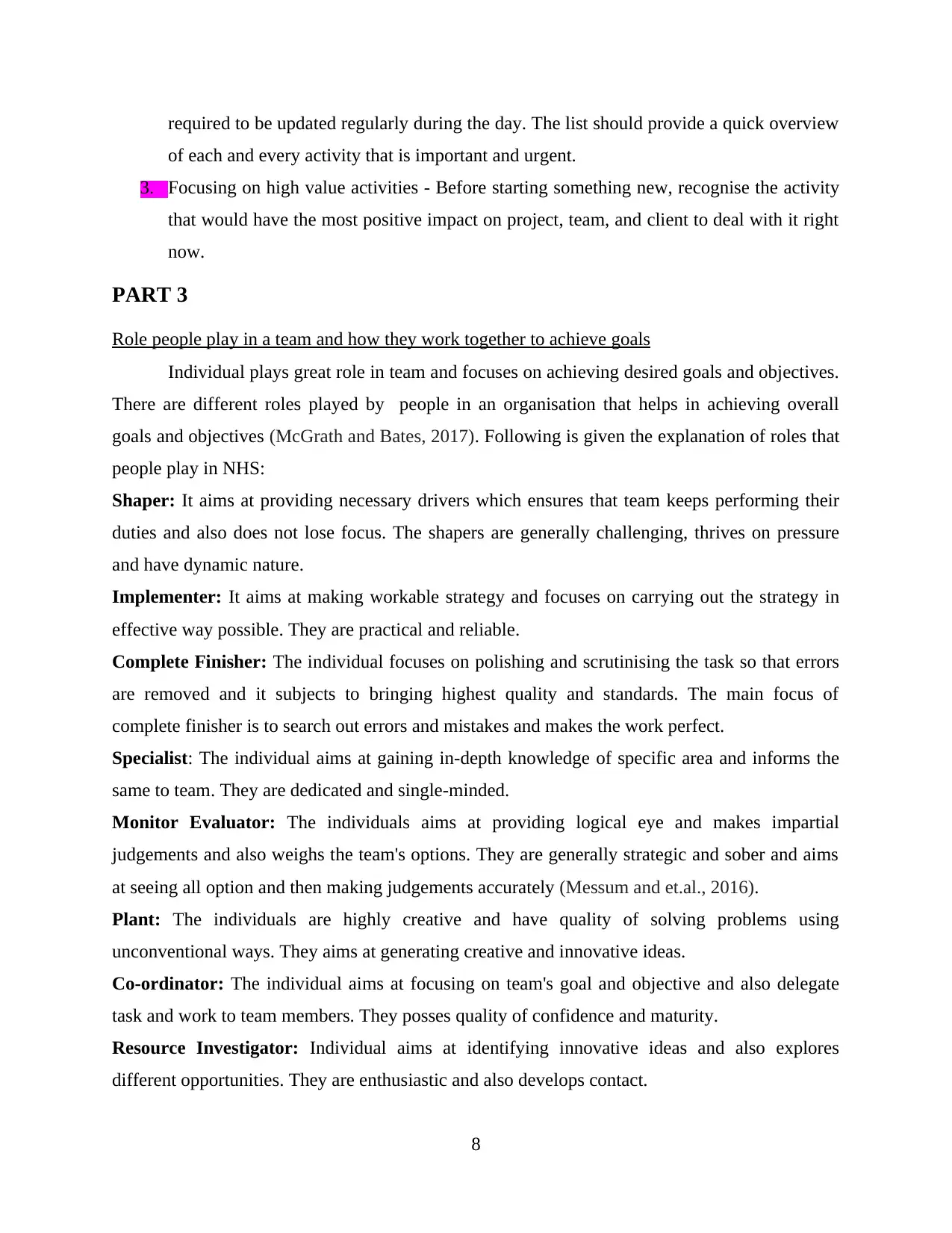
required to be updated regularly during the day. The list should provide a quick overview
of each and every activity that is important and urgent.
3. Focusing on high value activities - Before starting something new, recognise the activity
that would have the most positive impact on project, team, and client to deal with it right
now.
PART 3
Role people play in a team and how they work together to achieve goals
Individual plays great role in team and focuses on achieving desired goals and objectives.
There are different roles played by people in an organisation that helps in achieving overall
goals and objectives (McGrath and Bates, 2017). Following is given the explanation of roles that
people play in NHS:
Shaper: It aims at providing necessary drivers which ensures that team keeps performing their
duties and also does not lose focus. The shapers are generally challenging, thrives on pressure
and have dynamic nature.
Implementer: It aims at making workable strategy and focuses on carrying out the strategy in
effective way possible. They are practical and reliable.
Complete Finisher: The individual focuses on polishing and scrutinising the task so that errors
are removed and it subjects to bringing highest quality and standards. The main focus of
complete finisher is to search out errors and mistakes and makes the work perfect.
Specialist: The individual aims at gaining in-depth knowledge of specific area and informs the
same to team. They are dedicated and single-minded.
Monitor Evaluator: The individuals aims at providing logical eye and makes impartial
judgements and also weighs the team's options. They are generally strategic and sober and aims
at seeing all option and then making judgements accurately (Messum and et.al., 2016).
Plant: The individuals are highly creative and have quality of solving problems using
unconventional ways. They aims at generating creative and innovative ideas.
Co-ordinator: The individual aims at focusing on team's goal and objective and also delegate
task and work to team members. They posses quality of confidence and maturity.
Resource Investigator: Individual aims at identifying innovative ideas and also explores
different opportunities. They are enthusiastic and also develops contact.
8
of each and every activity that is important and urgent.
3. Focusing on high value activities - Before starting something new, recognise the activity
that would have the most positive impact on project, team, and client to deal with it right
now.
PART 3
Role people play in a team and how they work together to achieve goals
Individual plays great role in team and focuses on achieving desired goals and objectives.
There are different roles played by people in an organisation that helps in achieving overall
goals and objectives (McGrath and Bates, 2017). Following is given the explanation of roles that
people play in NHS:
Shaper: It aims at providing necessary drivers which ensures that team keeps performing their
duties and also does not lose focus. The shapers are generally challenging, thrives on pressure
and have dynamic nature.
Implementer: It aims at making workable strategy and focuses on carrying out the strategy in
effective way possible. They are practical and reliable.
Complete Finisher: The individual focuses on polishing and scrutinising the task so that errors
are removed and it subjects to bringing highest quality and standards. The main focus of
complete finisher is to search out errors and mistakes and makes the work perfect.
Specialist: The individual aims at gaining in-depth knowledge of specific area and informs the
same to team. They are dedicated and single-minded.
Monitor Evaluator: The individuals aims at providing logical eye and makes impartial
judgements and also weighs the team's options. They are generally strategic and sober and aims
at seeing all option and then making judgements accurately (Messum and et.al., 2016).
Plant: The individuals are highly creative and have quality of solving problems using
unconventional ways. They aims at generating creative and innovative ideas.
Co-ordinator: The individual aims at focusing on team's goal and objective and also delegate
task and work to team members. They posses quality of confidence and maturity.
Resource Investigator: Individual aims at identifying innovative ideas and also explores
different opportunities. They are enthusiastic and also develops contact.
8
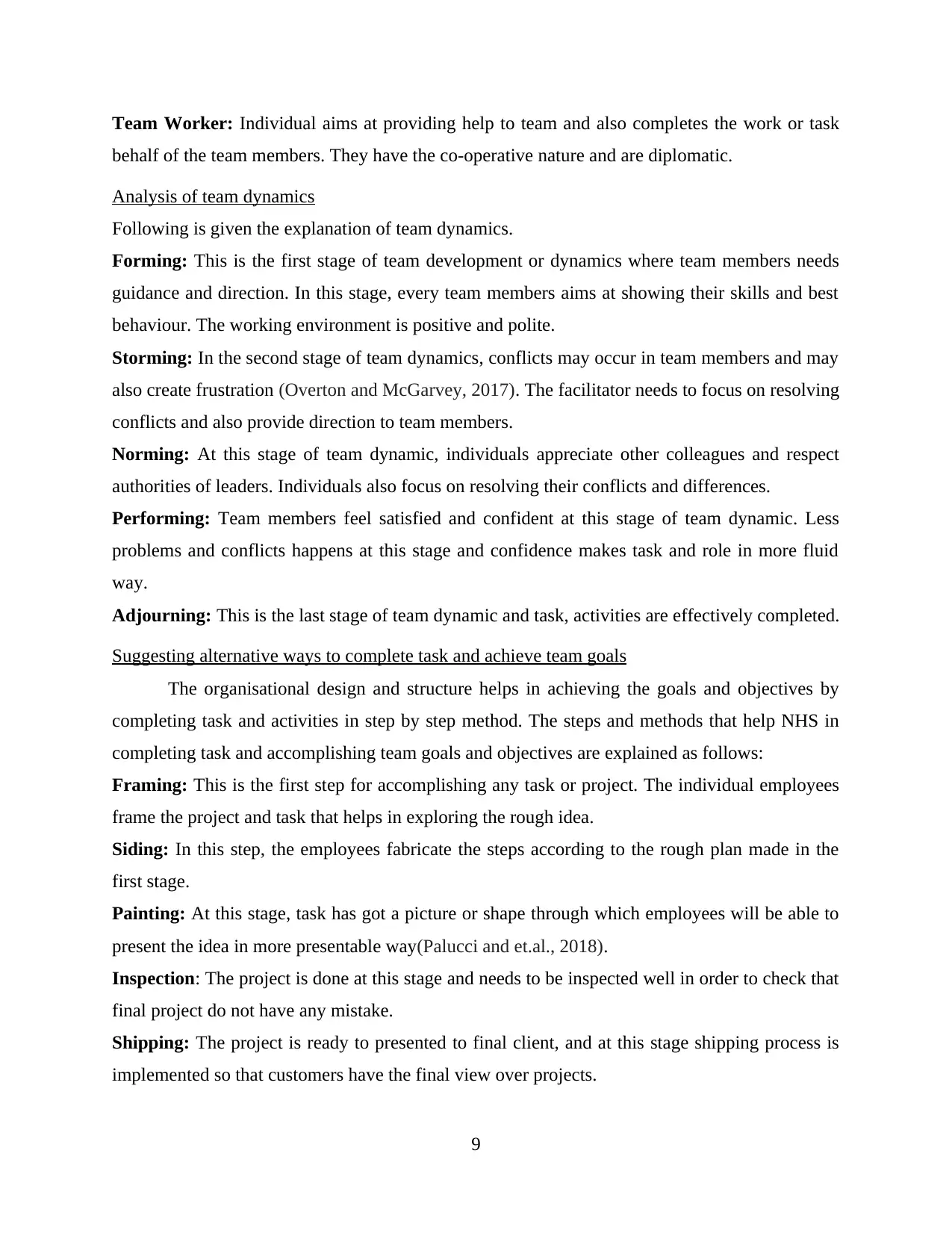
Team Worker: Individual aims at providing help to team and also completes the work or task
behalf of the team members. They have the co-operative nature and are diplomatic.
Analysis of team dynamics
Following is given the explanation of team dynamics.
Forming: This is the first stage of team development or dynamics where team members needs
guidance and direction. In this stage, every team members aims at showing their skills and best
behaviour. The working environment is positive and polite.
Storming: In the second stage of team dynamics, conflicts may occur in team members and may
also create frustration (Overton and McGarvey, 2017). The facilitator needs to focus on resolving
conflicts and also provide direction to team members.
Norming: At this stage of team dynamic, individuals appreciate other colleagues and respect
authorities of leaders. Individuals also focus on resolving their conflicts and differences.
Performing: Team members feel satisfied and confident at this stage of team dynamic. Less
problems and conflicts happens at this stage and confidence makes task and role in more fluid
way.
Adjourning: This is the last stage of team dynamic and task, activities are effectively completed.
Suggesting alternative ways to complete task and achieve team goals
The organisational design and structure helps in achieving the goals and objectives by
completing task and activities in step by step method. The steps and methods that help NHS in
completing task and accomplishing team goals and objectives are explained as follows:
Framing: This is the first step for accomplishing any task or project. The individual employees
frame the project and task that helps in exploring the rough idea.
Siding: In this step, the employees fabricate the steps according to the rough plan made in the
first stage.
Painting: At this stage, task has got a picture or shape through which employees will be able to
present the idea in more presentable way(Palucci and et.al., 2018).
Inspection: The project is done at this stage and needs to be inspected well in order to check that
final project do not have any mistake.
Shipping: The project is ready to presented to final client, and at this stage shipping process is
implemented so that customers have the final view over projects.
9
behalf of the team members. They have the co-operative nature and are diplomatic.
Analysis of team dynamics
Following is given the explanation of team dynamics.
Forming: This is the first stage of team development or dynamics where team members needs
guidance and direction. In this stage, every team members aims at showing their skills and best
behaviour. The working environment is positive and polite.
Storming: In the second stage of team dynamics, conflicts may occur in team members and may
also create frustration (Overton and McGarvey, 2017). The facilitator needs to focus on resolving
conflicts and also provide direction to team members.
Norming: At this stage of team dynamic, individuals appreciate other colleagues and respect
authorities of leaders. Individuals also focus on resolving their conflicts and differences.
Performing: Team members feel satisfied and confident at this stage of team dynamic. Less
problems and conflicts happens at this stage and confidence makes task and role in more fluid
way.
Adjourning: This is the last stage of team dynamic and task, activities are effectively completed.
Suggesting alternative ways to complete task and achieve team goals
The organisational design and structure helps in achieving the goals and objectives by
completing task and activities in step by step method. The steps and methods that help NHS in
completing task and accomplishing team goals and objectives are explained as follows:
Framing: This is the first step for accomplishing any task or project. The individual employees
frame the project and task that helps in exploring the rough idea.
Siding: In this step, the employees fabricate the steps according to the rough plan made in the
first stage.
Painting: At this stage, task has got a picture or shape through which employees will be able to
present the idea in more presentable way(Palucci and et.al., 2018).
Inspection: The project is done at this stage and needs to be inspected well in order to check that
final project do not have any mistake.
Shipping: The project is ready to presented to final client, and at this stage shipping process is
implemented so that customers have the final view over projects.
9
⊘ This is a preview!⊘
Do you want full access?
Subscribe today to unlock all pages.

Trusted by 1+ million students worldwide
1 out of 15
Related Documents
Your All-in-One AI-Powered Toolkit for Academic Success.
+13062052269
info@desklib.com
Available 24*7 on WhatsApp / Email
![[object Object]](/_next/static/media/star-bottom.7253800d.svg)
Unlock your academic potential
Copyright © 2020–2025 A2Z Services. All Rights Reserved. Developed and managed by ZUCOL.




